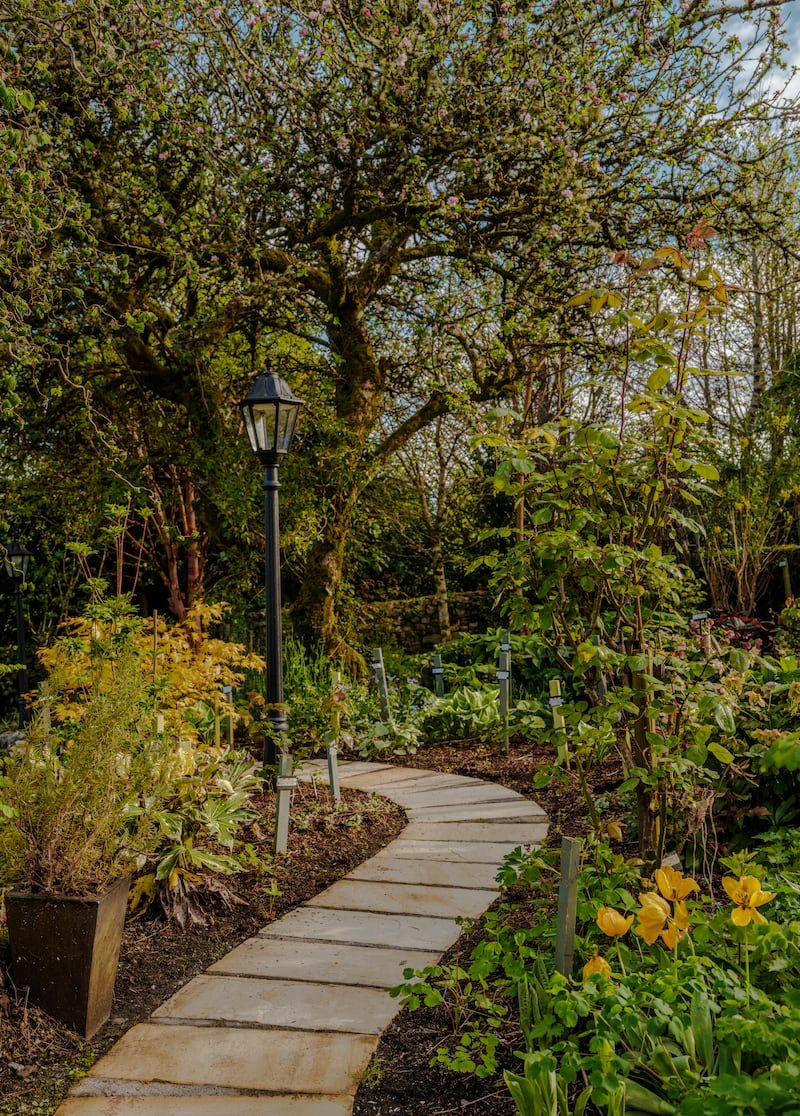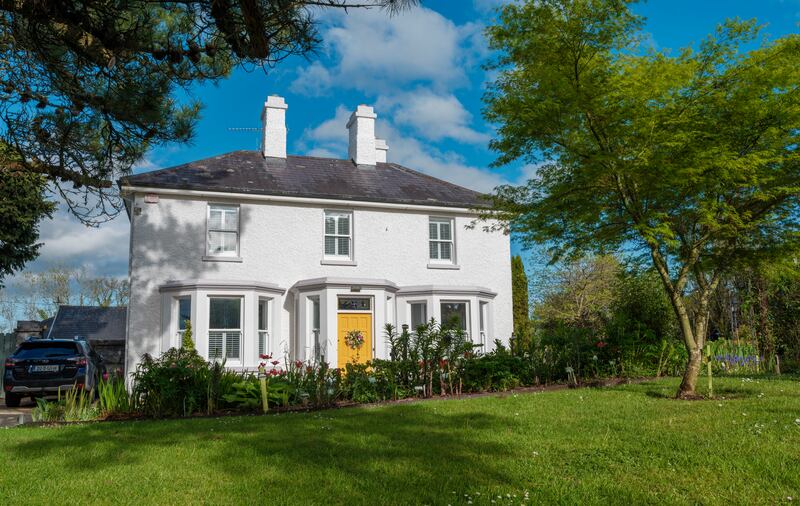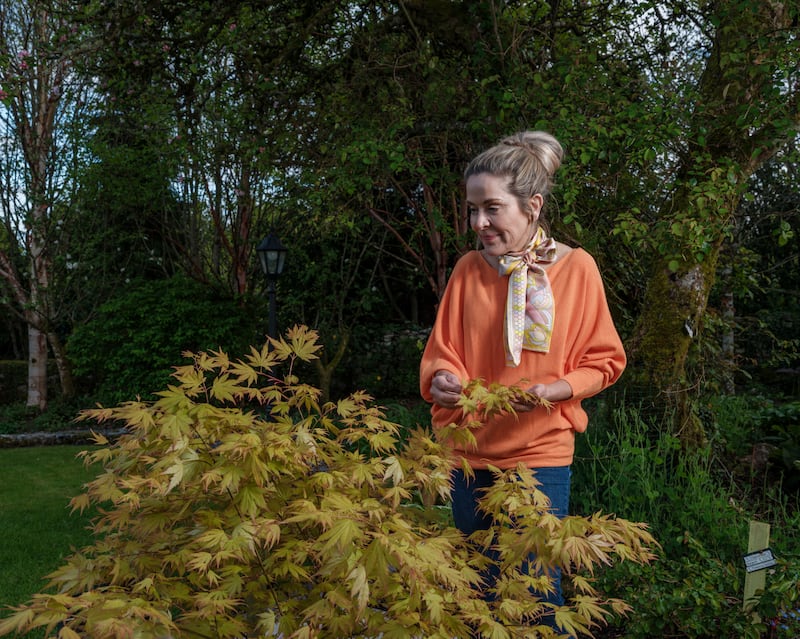It could be a portal to the magical world of Alice in Wonderland, but the arched doorway on the old drystone “mearing” wall, once part of the Ashford Castle estate, was a pandemic project for Trish Findlater. She calls it her “secret garden” and her own “little folly”.
Indeed, the door’s heart-shaped peephole to the garden of Glennina House – the home she shared with her late husband Alex until tragedy struck in 2019 – undoubtedly helped inspire her new book of paintings and poems, Grief’s Dark Seed and Hope’s Blossom.
The limited-edition book is an exploration of how the seasonal story of her garden reflected the narrative of her grief: from snow-covered winter scenes, “the frozen confinement” of her loss, to the summer scene of blue agapanthus and miscanthus grasses waving from the pond.
Alex Findlater was a member of one of Dublin’s most famous merchant families, whose fame ensured mentions in James Joyce’s Ulysses, as well as Finnegan’s Wake.
His forebears were Scottish excisemen who established a wine and grocery business in Dublin in 1823. Other enterprises included the Mountjoy Brewery and hotels in Bray and Howth. The family owned 21 shops in the city by the time Alex took over the business in 1955. However, the rise of supermarket chains led to the closure of Findlater’s Corner, on O’Connell Street, but ever innovative, he helped to establish Findlater Wines Merchants in 1974, ultimately selling the firm to Cantrell & Cochrane in 2001.
At this stage, Alex had already met Trish Fitzpatrick, his second wife, whom he married in 2010 and went on to enjoy a happy, busy and fun-filled life until tragedy struck in May 2019.


Alex died from a catastrophic brain injury after a horse-riding accident while the couple were holidaying in Punjab, India. The disaster was exacerbated by the complexities of getting him home to the care of his own doctor and hospital specialists, and the heartbreak of a three-week battle to save him.
Unsurprisingly, after the protracted trauma of her husband’s death, Trish escaped back to the home the couple had bought in Co Mayo in 2006.
Built by Lord Ardilaun in 1898 as a doctor’s house for the tenantry of the townland of Lisloughrey which was part of the vast Ashford Castle estate, Glennina is a classic Victorian House. A later extension of two adjoining hexagonal conservatories now frames a large patio and the lower garden.

“I suppose we created an eclectic ambience with nice old heavy furniture, some of the pieces are heirlooms from both our families to the sculpture, for example, of a multicoloured French bulldog we bought in Uzès [near Nîmes in southern France],” says Trish.
As well as being a graduate of Fine Art studies, she also studied interior architecture, which was often put into practice in the redecoration of their new home.


Take the big white marble fireplace in one of the living rooms, it is an excellent example of a tromp l’oeil (deceives the eye).
“The fireplace was originally a dark grey carrara marble, in the formality of the doctor’s waiting room but I painted it to look like arabescato marble so as to brighten up the room,” she says.
She also restored a lot of the old cornices by taking moulds and replacing them.
While the walls of Glennina are filled with her paintings — fishing trips to the Bahamas, Andalusian horses, Alex’s hockey sticks, from his days at Trinity College — the garden is the most important space and a pervading passion.
Each section is like a different room, she says, as we sit on the patio, drinking coffee.
“Alex used to say the garden was like an orchestra: as one musical note tapered off, a new one would burst open. There is a constant ebb and flow,” says Trish.
It is no surprise that when she originally started her book, she considered calling it “A thousand pots in a field”, because of the huge number of plants they brought west from their Dublin home.
“Before we moved here, we were living in a beautiful house called Riversdale, in Rathgar. The garden was spectacular and went all the way down to the river Dodder. When we bought Glennina in 2006, I was back studying interior architecture in Griffith College, whilst still running an interiors shop in Deansgrange, so Alex headed off west and got on with developing the garden. It was really a blank canvas and he landed down here with his expert gardener friend, Jimi Blake and a van load of perennials in pots taken from Riversdale. They included his prize peony, magnolias and endless hostas.
“We also inherited a giant Monterey tree on the front lawn and an old crab apple tree in the lower garden on which he coaxed an Albertine rose to grow right up to the top. He called these roses the tree’s crown,” she recalls.
Interestingly, the artistic flourishes of the living palette of colour collide with a scientific rigour which Alex inherited from his gardening aunts Doris and Gránia.
True to this tradition, Trish continues to label every plant with their Latin and English names.
“Well, this is where Alex lives now here in the garden. He was always such a ball of energy and if the law of thermal dynamics is correct, his energy is still out there. Also, I don’t feel it was some arbitrary thing that I was able to rise out of my profound grief again and embrace the garden,” she says.


After two long years of being crippled by grief, Trish gradually turned for comfort to the two-acre garden where she easily found a connection to Alex among the earth, seeds and plants that she now dug, hewed, sowed and pruned.
“I continued his meticulous labelling of the plants, shrubs and trees and tended the herbaceous and perennial borders. I also began to write out my feelings of grief in little clumsy soundings.”
This musing appears in the Winter section of the book: “You, grief! what are you? You ambush me, seize me, your blackness like a wet heavy rag across my shoulders, the weight unbearable and aching, You, grief! leave me be.”
Then, tentatively, she started painting in her abandoned studio at the end of the garden.


“First, I found myself painting the Albertine rose climbing up the old crab apple tree and that was the beginning of the idea for the book, which has 36 paintings and 14 of my little poems,” she says.
The old crab apple tree goes back to the beginning of Alex’s and Trish’s odyssey at Glennina.
It is no surprise then, that sometimes she finds herself gazing at it and saying: “Alex, look, there is a new rose budding at the top.”
Designed and published by Kate Horgan of Bespoke Books, Grief’s Dark Seed and Hope’s Blossom. trishfindlaterartist.com












